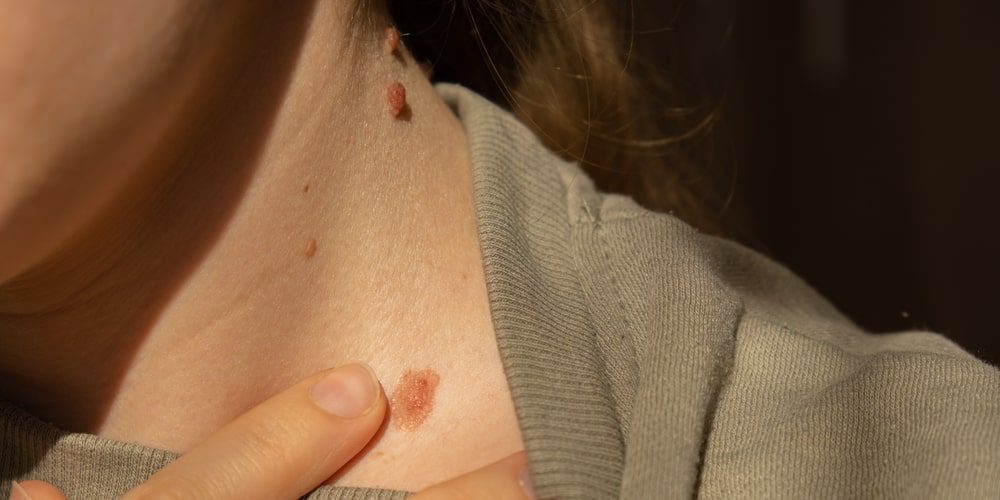Skin cancer shows up when something changes in how your skin cells grow, such as exposure to ultraviolet light. Some symptoms could include new bumps or patches on your skin, or even changes in the size, shape, or color of skin growths.
The majority of skin cancer is quite treatable, as long as it’s caught in time. Treatments include Mohs surgery, cryotherapy, chemotherapy, and radiation. As skin cells grow old and die, brand-new cells form and replace them.
When this process takes place in a toxic way, cells grow faster. A good example of toxicity implies exposure to ultraviolet (UV) light from the sun. Some cells might be noncancerous (benign), which don’t spread or cause harm.
Or, they could be cancerous. Skin cancer could easily spread to nearby tissue or other parts of your body if it’s not caught on time. Luckily, if skin cancer is identified and treated in some of the earliest stages, most are cured. So, it’s very important to talk with your healthcare provider if you suspect skin cancer.

Types of skin cancer
There are three main types of skin cancer:
- basal cell carcinoma – forms in your basal cells, in the lower part of the epidermis, which is basically the outside layer of your skin.
- squamous cell carcinoma – forms in your squamous cells in the outside layer of your skin.
- melanoma – forms in cells called melanocytes. They produce melatonin, a brown pigment that colors the skin and protects against some of the sun’s damaging UV rays. This is probably the most serious type of skin cancer because it can easily spread to other areas of your body.
Here are other types of skin cancer:
- Kaposi sarcoma
- Merkel cell carcinoma
- Sebaceous gland carcinoma
- Dermatofibrosarcoma protuberans
How common is it?
Skin cancer is probably the most common cancer in the United States. As a matter of fact, about 1 in 5 people develop skin cancer at some point in their life.
What are the signs and symptoms of skin cancer?
Probably the most common warning sign of skin cancer is a certain change in your skin. It usually implies a new growth or a specific change in an existing growth or mole. Skin cancer symptoms also include:
- a brand new mole, or one that changes its size, shape, or color, or even bleeds;
- a waxy bump on your face, ears, or even neck;
- a flat, pink, red, or brown-colored patch or bump;
- certain areas in your skin that look like scars;
- sores that have a crusty appearance, a depression in the middle, or bleed a lot;
- a sore that doesn’t heal, or that heals but comes back again;
- a rough and scaly lesion that could itch, bleed, and become crusty.
What does skin cancer look like?
Skin cancer looks quite different, and it all depends on what type of skin cancer you have. Thinking of the ABCDE rule will show you what to watch for:
- Asymmetry – irregular shape.
- Border – blurry or irregularly shaped edges.
- Color – mole with multiple colors.
- Diameter – larger than a pencil eraser (6 millimeters).
- Evolution – enlarging, changing in shape, color, or even size (this is definitely the most important sign).
If you are worried about a mole or any other skin lesion, you need to make an appointment and show it to your healthcare provider. They might check your skin, ask you to see a dermatologist, and even have the lesion further observed and evaluated.
What exactly causes this condition?
The number one reason for skin cancer is overexposure to sunlight, specifically when you suffer from sunburn and blistering. UV rays from the sun could also damage the DNA in your skin, which would further cause abnormal cells to form. All these abnormal cells could rapidly divide in a disorganized way, forming a damaging mass of cancer cells.
What are the risk factors for skin cancer?
Anyone can have it. However, some groups get it more than others. Before reaching 50, skin cancer is much more common in women and people assigned female at birth. But after reaching 50, it’s more common in men and people assigned male at birth.
In fact, it’s about 30 times more common in non-Hispanic white people than non-Hispanic Black people or even people of Asian or Pacific Islander descent. For people with darker skin tones, skin cancer is discovered much later, oftentimes in advanced stages, which makes it more difficult to treat.
Even if anyone can develop skin cancer, you’re much more at risk if you:
- spend a good amount of time in the sun.
- get easily sunburned or have quite a history of sunburns (to avoid that, make sure you always use a 60+ SPF cream).
- live in a sunny or high-altitude climate.
- tan or use tanning beds.
- have light-colored eyes, red hair, and freckled skin.
- have plenty of irregularly shaped moles.
- suffer from actinic keratosis.
- have a history of skin cancer in your family.
- have had an organ transplant.
- have been exposed to UV light therapy for treating skin conditions like psoriasis or eczema.
- Take medications that weaken your immune system.
How do doctors diagnose it?
First, you need to get checked by a dermatologist. You will be asked if you’ve noticed any changes in your moles, freckles, or any other type of skin spots, or even if you’ve noticed any new skin growths. Next, they will examine all your skin, including your scalp, ears, palms of your hands, soles of your feet, between your toes, and around your intimate parts.

What tests can diagnose skin cancer?
If your provider suspects you have skin cancer, they could perform a biopsy. In that biopsy, a sample of the tissue is removed and sent to a laboratory, where a pathologist can examine it under a microscope. Then, your dermatologist might tell you if your skin lesion is cancerous, what type it is, and discuss other treatment options.
Treatment
Treatment mainly depends on the stage of cancer. At times, a biopsy alone could remove all the cancer tissue, if we’re not talking about enlarged dimensions and it occupies a limited surface of your skin. Other very common skin cancer treatments used alone or combined, could include:
Cryotherapy
Your dermatologist will use liquid nitrogen to freeze the skin affected by cancer. The dead cells slough off after the treatment.
Excisional surgery
Your dermatologist will remove the tumor and some surrounding healthy skin to make sure all the cancer is gone.
Mohs surgery
Your dermatologist focuses solely on diseased tissue, trying to save as much as possible from the surrounding normal tissue. Providers will use this to treat basal cell but also all squamous cell cancers, and other skin cancers that could develop close to sensitive or cosmetically important areas of your body.
Curettage and electrodesiccation
Your dermatologist will use an instrument with a sharp and looped edge to remove all the cancer cells as it scrapes all over the tumor. Then, they will use an electric needle to destroy any cancer cells left. Providers will then use this to treat basal cell and squamous cell cancers, but also precancerous skin tumors.
Chemotherapy
Your dermatologist or oncologist will use traditional medications to kill the cancer cells. Anticancer medications might be applied directly on the skin, which is called topical chemotherapy, if limited to your skin’s top layer. Also, they can give you pills or an IV if the cancer spreads to other parts of your body.
Immunotherapy
Your oncologist gives you medications to help your immune system kill cancer cells.
Radiation therapy
Your radiation oncologist uses radiation to kill the cancer cells, or at least keep them from growing and dividing.
Photodynamic therapy
Your dermatologist offers medication for the skin, which activates in contact with a blue or red fluorescent light. This therapy destroys precancerous cells but leaves the normal ones alone.
If you’re interested in reading other similar articles, we also recommend: 10 Simple Foods That Make Your Flu Symptoms Worse













